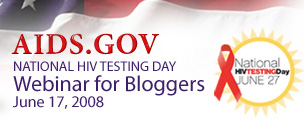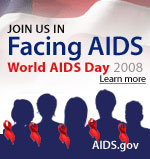Reaching Bloggers for National HIV Testing Day

Last week, AIDS.gov hosted a Webinar  for bloggers in advance of National HIV Testing Day (on June 27). We reached out to bloggers for this event because so many people today depend on bloggers for their news, information, and opinions.
for bloggers in advance of National HIV Testing Day (on June 27). We reached out to bloggers for this event because so many people today depend on bloggers for their news, information, and opinions.
Who participated in the Webinar?
Participants included bloggers who blog about health-related topics and/or those who reach communities infected, affected, or at highest risk for HIV. Several of our Federal colleagues also attended the Webinar. Timothy Harrison from HHS’ Office of HIV/AIDS Policy was the moderator, and Dr. Bernie Branson from the CDC, Dr. Celia Maxwell  from Howard University Hospital, and Mr. Andre Blackman
from Howard University Hospital, and Mr. Andre Blackman  from the Pulse & Signal Blog
from the Pulse & Signal Blog  presented and answered questions from bloggers.
presented and answered questions from bloggers.

Timothy Harrison from HHS’ Office of HIV/AIDS Policy

Dr. Bernie Branson from the CDC

Dr. Celia Maxwell from Howard University Hospital

Mr. Andre Blackman from the Pulse & Signal Blog
How can bloggers help promote National HIV Testing Day?
- Take an HIV test
 and then blog about it.
and then blog about it. - Promote web badges
 on your blog that link people to the KNOWIT HIV testing text messaging campaign.
on your blog that link people to the KNOWIT HIV testing text messaging campaign. - Promote the HIV testing PPSAs we blogged about last week and mentioned during the Webinar.
- Link to the Webinar transcript.
- Host or attend a local event
 for National HIV Testing Day and blog about it.
for National HIV Testing Day and blog about it.
What HIV testing messages were heard on the Webinar?
- Some of the biggest barriers to getting tested for HIV include: stigma, fear of the results, perception of not being at-risk, and assuming their healthcare provider has already tested them.
- Getting an HIV test can be quick and painless! As Dr. Maxwell told us, “results can be given to the person in as little as 20 minutes. It involves a swab of the inner lining of the mouth.”
- The HIV epidemic is disproportionately impacting African Americans and men who have sex with men (MSM). Dr. Branson shared that “49 percent of all reported cases of AIDS in the United States occur among African Americans who represent only 12 percent of the population.”
- Don't be afraid to ask your healthcare provider for a test. Dr. Maxwell said, “I often say to patients this is really no different than getting your Pap smear if you’re a woman...or knowing your cholesterol. This is part of being well!”
- If you test positive for HIV, treatment and care are available which may help improve your health and protect your partners. To learn more about living with HIV please visit the “treatment and care” section on AIDS.gov.
What did bloggers ask about?
During the Webinar, we answered live questions from bloggers--check out the transcript. Unfortunately, we didn’t get all the questions during the Webinar, so we’ve responded to additional questions here.
What’s up next?
In closing, the AIDS.gov team wants to thank all the participants, speakers, and organizers that made this Webinar possible! We also encourage you to help spread the word about National HIV Testing Day on June 27.
Next week we’ll be returning to our series on virtual worlds...stay tuned!!




I am incredibly dismayed by the lack of depth in understanding the intersection of HIV transmission and new media by your recent webinar panel members. As a blogger I have posted extensively about the tragically misunderstood struggle that drives same sex attracted men of color to online hook-up sites in search of quick, anonymous sexual encounters. Many of these men either misrepresent or outright lie about their HIV status in their profiles and/or in their subsequent communications with potential partners in advance of the actual encounter. Furthermore, the privacy that a home encounter affords the participants often leads to an engagement of riskier sexual behavior than either party may have intended. Very little, if any, conversation around risk evaluation, STI status, or safer sex behaviors occurs within this context of getting off quickly and getting out. Finally, the intense shame, guilt, and loneliness that often follows the encounter only fuels the desire for yet another encounter with a new partner to ease this extreme discomfort.
And I've only scratched the surface here. No HIV prevention, treatment, or testing initiative will ever generate sustainable reductions in primary and secondary transmission rates as long as they ignore the compulsive/addictive foundation from which these encounters grow and multiply. In several blog posts, I speak about my own struggle with compulsive sex and how traditional evaluation and treatment methods failed to address this. I was hoping, when i received an invitation to participate in the webinar, that I would be able to speak at length on this, but technical difficulties apparently prevented me from doing so. How unfortunate also that the panel you'd chosen seemed to have little direct connection or even insight into the mindset of individuals who use new media to facilitate these anonymous, compulsive encounters that without question carry extreme risk for transmission of HIV and other STI's.
I'll continue to do my part to document my struggle in the hopes that policy makers represented in your organization will take notice and begin to craft and implement strategies to directly address this.
JNez
www.thirtydaes.com
Posted by: JNez | June 26, 2008 at 09:12 PM
Sharing needles for drug injection is a well known route of HIV transmission, yet injection drug use contributes to the epidemic's spread far beyond the circle of those who inject. People who have sex with an injection drug user (IDU) also are at risk for infection through sexual HIV transmission. And, children born to mothers who contracted HIV through injecting drugs or having sex with an IDU may become infected as well.
Since the epidemic began, injection drug use has directly and indirectly accounted for more than one-third (36%) of AIDS cases in the United States. This disturbing trend appears to be continuing. Of the 60,634 new cases of AIDS reported in 1997, 19,463 (32%) were IDU-associated.
76% of these cases were among people whose only reported risk factor was injection drug use.
12% were among male IDUs who also reported having sex with other men.
11% were among men and women whose sex partners were IDUs.
1% were among children born to mothers who were either IDUs or the sex partners of IDUs.
Posted by: dreamcon | June 27, 2008 at 03:34 AM
The issue of people using the internet to engage in unhealthy behaviors is certainly very important to us. We regret having missed an opportunity to include a dialog on this topic in our webinar, but appreciate your taking the time to share your perspective on this blog.
We will make an effort to include this issue in future events.
Posted by: AIDS.gov | July 01, 2008 at 05:48 PM
I would like to to see the "Aids Message" displayed where the youth are congregating on the net, like YouTube for example. Some 2-3 min long video clips will get a lot of views and the message will be well received.
Posted by: Tom Lee | July 09, 2008 at 11:29 AM
Its a fantastic effort from your side to reach out to all. But awareness among everyone is exremely important. Kindly speak about the same in some of your posts.
Posted by: Ethnu | July 09, 2008 at 01:40 PM
I'm waiting to see a comprehensible report on Aids in the white community
Posted by: Eugene Martin | July 29, 2008 at 12:31 PM